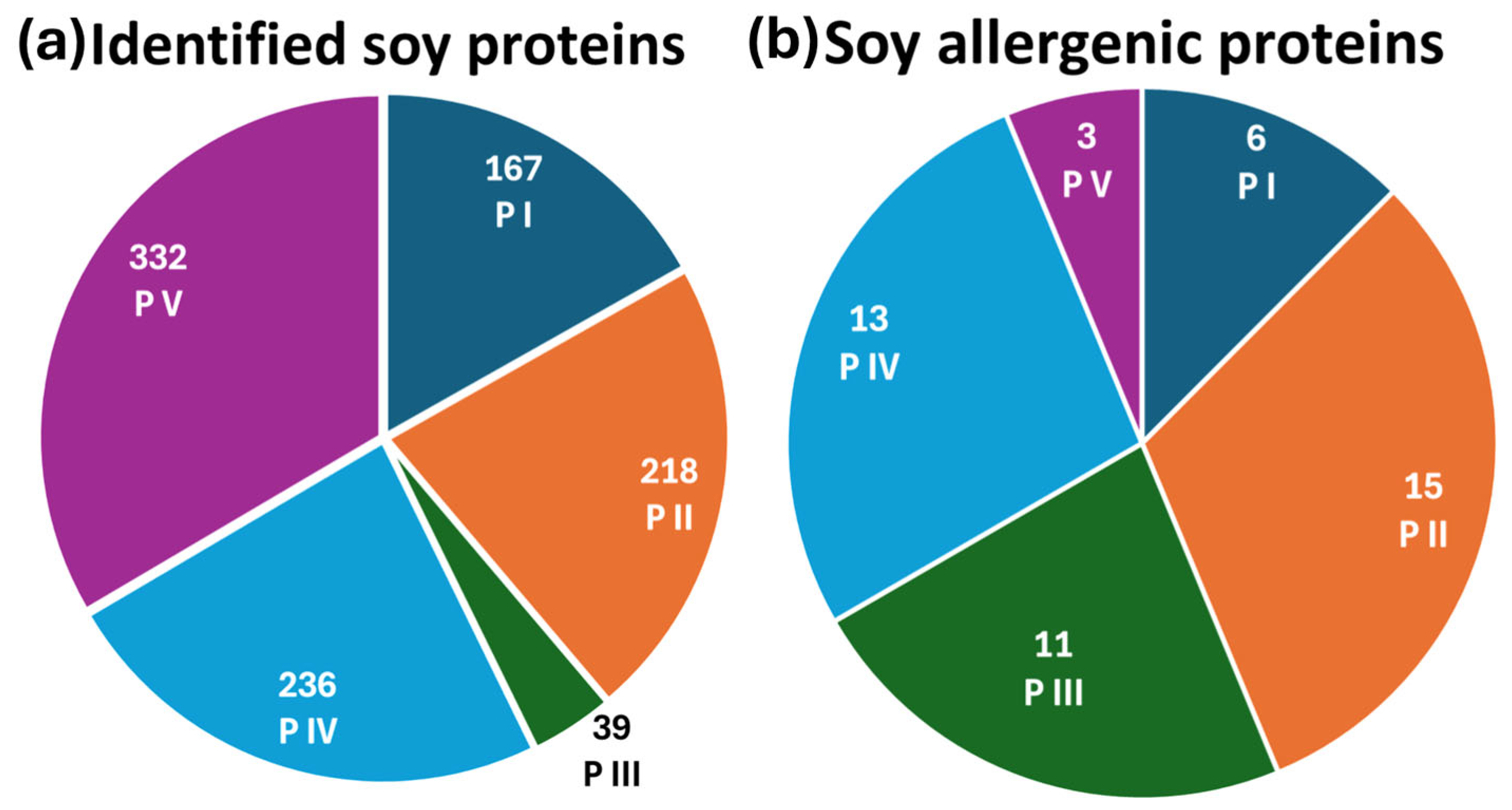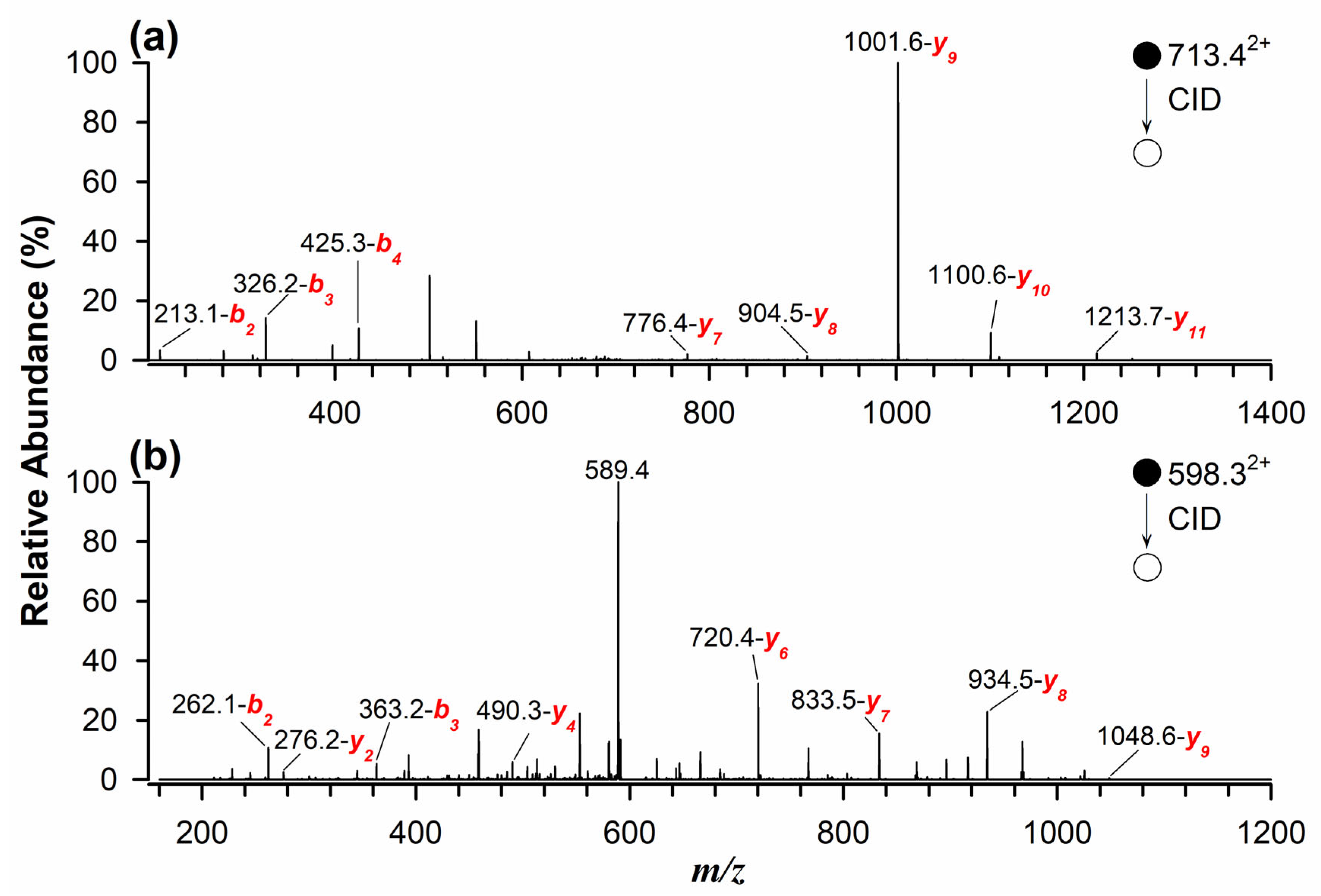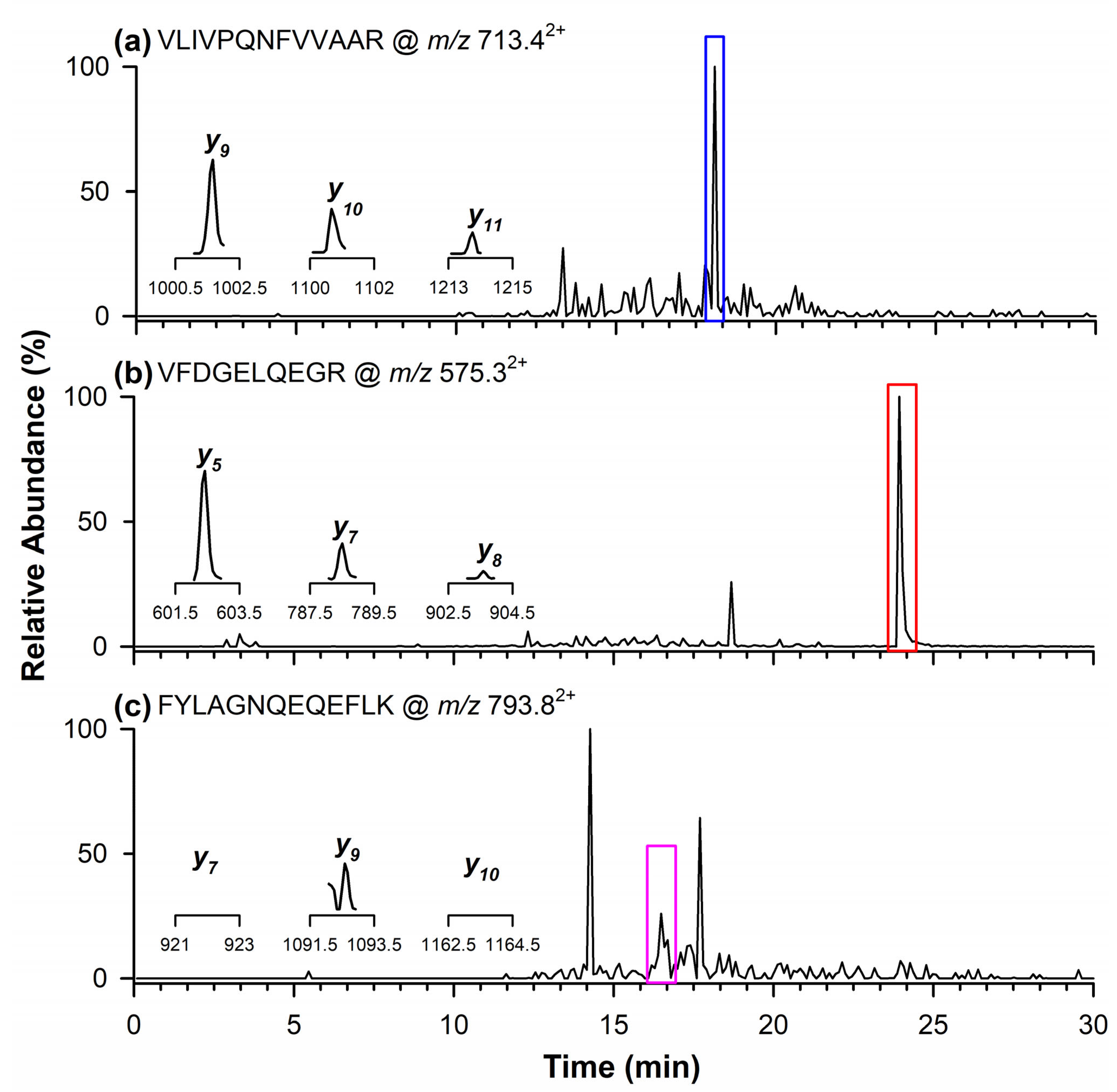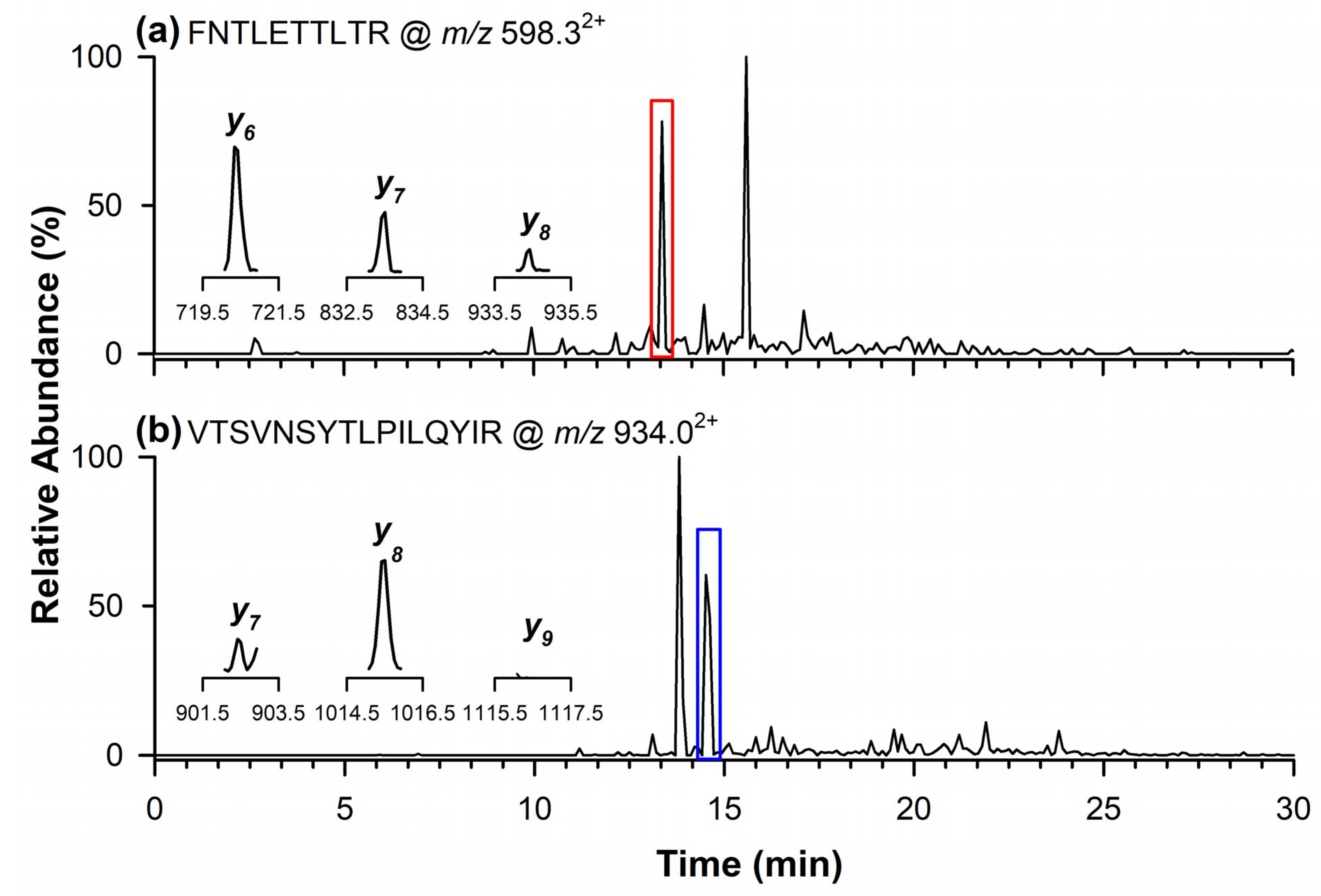Contamination of Wheat Flour and Processed Foodstuffs with Soybean and Mustard Allergenic Proteins
Abstract
1. Introduction
2. Results and Discussion
2.1. Evaluation of Protein Extraction Protocols for Allergen Identification
2.2. Identification of Marker Peptides of Soy and Mustard Allergenic Proteins
2.3. Analytical Method Validation for Glycinin G1 and 11S Globulin Quantification
2.4. Quantification of Soy and Mustard Allergens in Naturally Contaminated Samples
3. Material and Methods
3.1. Chemicals
3.2. Protein Extraction Protocols
3.3. Enzymatic Digestion Procedure
3.4. Preparation of Standard Solutions and Sample Analysis
3.5. LC-MS(/MS) Experimental Conditions
4. Conclusions
Supplementary Materials
Author Contributions
Funding
Institutional Review Board Statement
Informed Consent Statement
Data Availability Statement
Conflicts of Interest
References
- Waserman, S.; Watson, W. Food Allergy. Allergy Asthma Clin. Immunol. 2011, 7, S7. [Google Scholar] [CrossRef]
- Ortolani, C.; Pastorello, E.A. Food Allergies and Food Intolerances. Best Pract. Res. Clin. Gastroenterol. 2006, 20, 467–483. [Google Scholar] [CrossRef] [PubMed]
- Sicherer, S.H.; Sampson, H.A. Food Allergy. J. Allergy Clin. Immunol. 2010, 125, S116–S125. [Google Scholar] [CrossRef] [PubMed]
- Bianco, M.; Calvano, C.D.; Ventura, G.; Bianco, G.; Losito, I.; Cataldi, T.R.I. Regiochemical Assignment of N-Acylphosphatidylethanolamines (NAPE) by Liquid Chromatography/Electrospray Ionization with Multistage Mass Spectrometry and Its Application to Extracts of Lupin Seeds. J. Am. Soc. Mass Spectrom. 2020, 31, 1994–2005. [Google Scholar] [CrossRef]
- European Parliament Regulation (EU) No 1169/2011 of the European Parliament and of the Council. Off. J. Eur. Union 2011, L 304, 18–63.
- Taylor, S.L.; Nordlee, J.A.; Niemann, L.M.; Lambrecht, D.M. Allergen Immunoassays—Considerations for Use of Naturally Incurred Standards. Anal. Bioanal. Chem. 2009, 395, 83–92. [Google Scholar] [CrossRef]
- Besler, M.; Steinhart, H.; Paschke, A. Stability of Food Allergens and Allergenicity of Processed Foods. J. Chromatogr. B Biomed. Sci. Appl. 2001, 756, 207–228. [Google Scholar] [CrossRef] [PubMed]
- Besler, M. Determination of Allergens in Foods. TrAC Trends Anal. Chem. 2001, 20, 662–672. [Google Scholar] [CrossRef]
- Ito, K.; Yamamoto, T.; Oyama, Y.; Tsuruma, R.; Saito, E.; Saito, Y.; Ozu, T.; Honjoh, T.; Adachi, R.; Sakai, S.; et al. Food Allergen Analysis for Processed Food Using a Novel Extraction Method to Eliminate Harmful Reagents for Both ELISA and Lateral-Flow Tests. Anal. Bioanal. Chem. 2016, 408, 5973–5984. [Google Scholar] [CrossRef]
- Poms, R.E.; Klein, C.L.; Anklam, E. Methods for Allergen Analysis in Food: A Review. Food Addit. Contam. 2004, 21, 1–31. [Google Scholar] [CrossRef]
- Orcajo, J.; Lavilla, M.; Martínez-de-Marañón, I. Specific and Sensitive ELISA for Measurement of IgE-Binding Variations of Milk Allergen β-Lactoglobulin in Processed Foods. Anal. Chim. Acta 2019, 1052, 163–169. [Google Scholar] [CrossRef] [PubMed]
- Montserrat, M.; Sanz, D.; Juan, T.; Herrero, A.; Sánchez, L.; Calvo, M.; Pérez, M.D. Detection of Peanut (Arachis hypogaea) Allergens in Processed Foods by Immunoassay: Influence of Selected Target Protein and ELISA Format Applied. Food Control 2015, 54, 300–307. [Google Scholar] [CrossRef]
- Zhu, L.; Li, S.; Sun, L.; Zhao, J.; Huang, J.; Jiang, Y.; Wan, S.; Pavase, T.R.; Li, Z. Development and Validation of a Specific Sandwich ELISA for Determination of Soybean Allergens and Its Application in Processed Foods. Process Biochem. 2022, 117, 134–141. [Google Scholar] [CrossRef]
- Zhang, M.; Wu, P.; Wu, J.; Ping, J.; Wu, J. Advanced DNA-Based Methods for the Detection of Peanut Allergens in Processed Food. TrAC Trends Anal. Chem. 2019, 114, 278–292. [Google Scholar] [CrossRef]
- Linacero, R.; Sanchiz, A.; Ballesteros, I.; Cuadrado, C. Application of Real-Time PCR for Tree Nut Allergen Detection in Processed Foods. Crit. Rev. Food Sci. Nutr. 2020, 60, 1077–1093. [Google Scholar] [CrossRef] [PubMed]
- Scaravelli, E.; Brohée, M.; Marchelli, R.; van Hengel, A.J. Development of Three Real-Time PCR Assays to Detect Peanut Allergen Residue in Processed Food Products. Eur. Food Res. Technol. 2008, 227, 857–869. [Google Scholar] [CrossRef]
- Stephan, O.; Vieths, S. Development of a Real-Time PCR and a Sandwich ELISA for Detection of Potentially Allergenic Trace Amounts of Peanut (Arachis hypogaea) in Processed Foods. J. Agric. Food Chem. 2004, 52, 3754–3760. [Google Scholar] [CrossRef]
- Kirsch, S.; Fourdrilis, S.; Dobson, R.; Scippo, M.-L.; Maghuin-Rogister, G.; De Pauw, E. Quantitative Methods for Food Allergens: A Review. Anal. Bioanal. Chem. 2009, 395, 57–67. [Google Scholar] [CrossRef]
- Planque, M.; Arnould, T.; Dieu, M.; Delahaut, P.; Renard, P.; Gillard, N. Advances in Ultra-High Performance Liquid Chromatography Coupled to Tandem Mass Spectrometry for Sensitive Detection of Several Food Allergens in Complex and Processed Foodstuffs. J. Chromatogr. A 2016, 1464, 115–123. [Google Scholar] [CrossRef]
- Torii, A.; Seki, Y.; Arimoto, C.; Hojo, N.; Iijima, K.; Nakamura, K.; Ito, R.; Yamakawa, H.; Akiyama, H. Development of a Simple and Reliable LC-MS/MS Method to Simultaneously Detect Walnut and Almond as Specified in Food Allergen Labelling Regulations in Processed Foods. Curr. Res. Food Sci. 2023, 6, 100444. [Google Scholar] [CrossRef]
- Ogura, T.; Clifford, R.; Oppermann, U. Simultaneous Detection of 13 Allergens in Thermally Processed Food Using Targeted LC–MS/MS Approach. J. AOAC Int. 2019, 102, 1316–1329. [Google Scholar] [CrossRef] [PubMed]
- Torii, A.; Seki, Y.; Sasano, R.; Ishida, Y.; Nakamura, K.; Ito, R.; Iwasaki, Y.; Iijima, K.; Akiyama, H. Development of a Rapid and Reliable Method to Simultaneously Detect Seven Food Allergens in Processed Foods Using LC-MS/MS. Food Chem. X 2024, 23, 101558. [Google Scholar] [CrossRef] [PubMed]
- Ma, X.; Li, H.; Zhang, J.; Huang, W.; Han, J.; Ge, Y.; Sun, J.; Chen, Y. Comprehensive Quantification of Sesame Allergens in Processed Food Using Liquid Chromatography-Tandem Mass Spectrometry. Food Control 2020, 107, 106744. [Google Scholar] [CrossRef]
- Korte, R.; Oberleitner, D.; Brockmeyer, J. Determination of Food Allergens by LC-MS: Impacts of Sample Preparation, Food Matrix, and Thermal Processing on Peptide Detectability and Quantification. J. Proteom. 2019, 196, 131–140. [Google Scholar] [CrossRef] [PubMed]
- Gavage, M.; Van Vlierberghe, K.; Van Poucke, C.; De Loose, M.; Gevaert, K.; Dieu, M.; Renard, P.; Arnould, T.; Gillard, N. Selection of Egg Peptide Biomarkers in Processed Food Products by High Resolution Mass Spectrometry. J. Chromatogr. A 2019, 1584, 115–125. [Google Scholar] [CrossRef]
- Korte, R.; Lepski, S.; Brockmeyer, J. Comprehensive Peptide Marker Identification for the Detection of Multiple Nut Allergens Using a Non-Targeted LC–HRMS Multi-Method. Anal. Bioanal. Chem. 2016, 408, 3059–3069. [Google Scholar] [CrossRef]
- New, L.S.; Schreiber, A.; Stahl-Zeng, J.; Liu, H.-F. Simultaneous Analysis of Multiple Allergens in Food Products by LC-MS/MS. J. AOAC Int. 2018, 101, 132–145. [Google Scholar] [CrossRef]
- Boo, C.C.; Parker, C.H.; Jackson, L.S. A Targeted LC-MS/MS Method for the Simultaneous Detection and Quantitation of Egg, Milk, and Peanut Allergens in Sugar Cookies. J. AOAC Int. 2018, 101, 108–117. [Google Scholar] [CrossRef]
- Korte, R.; Brockmeyer, J. MRM3-Based LC-MS Multi-Method for the Detection and Quantification of Nut Allergens. Anal. Bioanal. Chem. 2016, 408, 7845–7855. [Google Scholar] [CrossRef]
- Bianco, M.; Ventura, G.; Calvano, C.D.; Losito, I.; Cataldi, T.R.I. Discovery of Marker Peptides of Spirulina Microalga Proteins for Allergen Detection in Processed Foodstuffs. Food Chem. 2022, 393, 133319. [Google Scholar] [CrossRef]
- Pilolli, R.; Nitride, C.; Gillard, N.; Huet, A.-C.; van Poucke, C.; de Loose, M.; Tranquet, O.; Larré, C.; Adel-Patient, K.; Bernard, H.; et al. Critical Review on Proteotypic Peptide Marker Tracing for Six Allergenic Ingredients in Incurred Foods by Mass Spectrometry. Food Res. Int. 2020, 128, 108747. [Google Scholar] [CrossRef] [PubMed]
- Huschek, G.; Bönick, J.; Löwenstein, Y.; Sievers, S.; Rawel, H. Quantification of Allergenic Plant Traces in Baked Products by Targeted Proteomics Using Isotope Marked Peptides. LWT 2016, 74, 286–293. [Google Scholar] [CrossRef]
- Heick, J.; Fischer, M.; Pöpping, B. First Screening Method for the Simultaneous Detection of Seven Allergens by Liquid Chromatography Mass Spectrometry. J. Chromatogr. A 2011, 1218, 938–943. [Google Scholar] [CrossRef]
- Gu, S.; Chen, N.; Zhou, Y.; Zhao, C.; Zhan, L.; Qu, L.; Cao, C.; Han, L.; Deng, X.; Ding, T.; et al. A Rapid Solid-Phase Extraction Combined with Liquid Chromatography-Tandem Mass Spectrometry for Simultaneous Screening of Multiple Allergens in Chocolates. Food Control 2018, 84, 89–96. [Google Scholar] [CrossRef]
- Pilolli, R.; De Angelis, E.; Monaci, L. Streamlining the Analytical Workflow for Multiplex MS/MS Allergen Detection in Processed Foods. Food Chem. 2017, 221, 1747–1753. [Google Scholar] [CrossRef]
- Hoffmann, B.; Münch, S.; Schwägele, F.; Neusüß, C.; Jira, W. A Sensitive HPLC-MS/MS Screening Method for the Simultaneous Detection of Lupine, Pea, and Soy Proteins in Meat Products. Food Control 2017, 71, 200–209. [Google Scholar] [CrossRef]
- Posada-Ayala, M.; Alvarez-Llamas, G.; Maroto, A.S.; Maes, X.; Muñoz-Garcia, E.; Villalba, M.; Rodríguez, R.; Perez-Gordo, M.; Vivanco, F.; Pastor-Vargas, C.; et al. Novel Liquid Chromatography–Mass Spectrometry Method for Sensitive Determination of the Mustard Allergen Sin a 1 in Food. Food Chem. 2015, 183, 58–63. [Google Scholar] [CrossRef]
- L’Hocine, L.; Pitre, M.; Achouri, A. Detection and Identification of Allergens from Canadian Mustard Varieties of Sinapis Alba and Brassica Juncea. Biomolecules 2019, 9, 489. [Google Scholar] [CrossRef]
- Hummel, M.; Wigger, T.; Brockmeyer, J. Characterization of Mustard 2S Albumin Allergens by Bottom-up, Middle-down, and Top-down Proteomics: A Consensus Set of Isoforms of Sin a 1. J. Proteome Res. 2015, 14, 1547–1556. [Google Scholar] [CrossRef]
- Wang, X.; Li, X.; Deng, X.; Han, H.; Shi, W.; Li, Y. A Protein Extraction Method Compatible with Proteomic Analysis for the Euhalophyte Salicornia Europaea. Electrophoresis 2007, 28, 3976–3987. [Google Scholar] [CrossRef]
- Calvano, C.D.; Picca, R.A.; Bonerba, E.; Tantillo, G.; Cioffi, N.; Palmisano, F. MALDI-TOF Mass Spectrometry Analysis of Proteins and Lipids in Escherichia Coli Exposed to Copper Ions and Nanoparticles. J. Mass Spectrom. 2016, 51, 828–840. [Google Scholar] [CrossRef] [PubMed]
- Rahman, M.M.; Dutta, S.; Lamsal, B.P. High-power Sonication-assisted Extraction of Soy Protein from Defatted Soy Meals: Influence of Important Process Parameters. J. Food Process Eng. 2021, 44, e13720. [Google Scholar] [CrossRef]
- Wang, W.-Q.; Jensen, O.N.; Møller, I.M.; Hebelstrup, K.H.; Rogowska-Wrzesinska, A. Evaluation of Sample Preparation Methods for Mass Spectrometry-Based Proteomic Analysis of Barley Leaves. Plant Methods 2018, 14, 72. [Google Scholar] [CrossRef]
- Hayashi, M.; Pawankar, R.; Yamanishi, S.; Itoh, Y. Food-Dependent Exercise-Induced Anaphylaxis to Soybean: Gly m 5 and Gly m 6 as Causative Allergen Components. World Allergy Organ. J. 2020, 13, 100439. [Google Scholar] [CrossRef] [PubMed]
- Holzhauser, T.; Wackermann, O.; Ballmer-Weber, B.K.; Bindslev-Jensen, C.; Scibilia, J.; Perono-Garoffo, L.; Utsumi, S.; Poulsen, L.K.; Vieths, S. Soybean (Glycine max) Allergy in Europe: Gly m 5 (β-Conglycinin) and Gly m 6 (Glycinin) Are Potential Diagnostic Markers for Severe Allergic Reactions to Soy. J. Allergy Clin. Immunol. 2009, 123, 452–458.e4. [Google Scholar] [CrossRef] [PubMed]
- Tandang-Silvas, M.R.G.; Fukuda, T.; Fukuda, C.; Prak, K.; Cabanos, C.; Kimura, A.; Itoh, T.; Mikami, B.; Utsumi, S.; Maruyama, N. Conservation and Divergence on Plant Seed 11S Globulins Based on Crystal Structures. Biochim. Biophys. Acta-Proteins Proteom. 2010, 1804, 1432–1442. [Google Scholar] [CrossRef]
- Singh, A.; Meena, M.; Kumar, D.; Dubey, A.K.; Hassan, M.I. Structural and Functional Analysis of Various Globulin Proteins from Soy Seed. Crit. Rev. Food Sci. Nutr. 2015, 55, 1491–1502. [Google Scholar] [CrossRef]
- Wang, T.; Qin, G.-X.; Sun, Z.-W.; Zhao, Y. Advances of Research on Glycinin and β-Conglycinin: A Review of Two Major Soybean Allergenic Proteins. Crit. Rev. Food Sci. Nutr. 2014, 54, 850–862. [Google Scholar] [CrossRef]
- Palomares, O.; Cuesta-Herranz, J.; Vereda, A.; Sirvent, S.; Villalba, M.; Rodríguez, R. Isolation and Identification of an 11S Globulin as a New Major Allergen in Mustard Seeds. Ann. Allergy Asthma Immunol. 2005, 94, 586–592. [Google Scholar] [CrossRef]
- Rahaman, T.; Vasiljevic, T.; Ramchandran, L. Effect of Processing on Conformational Changes of Food Proteins Related to Allergenicity. Trends Food Sci. Technol. 2016, 49, 24–34. [Google Scholar] [CrossRef]
- Vanga, S.K.; Singh, A.; Raghavan, V. Review of Conventional and Novel Food Processing Methods on Food Allergens. Crit. Rev. Food Sci. Nutr. 2017, 57, 2077–2094. [Google Scholar] [CrossRef] [PubMed]
- Sathe, S.K.; Sharma, G.M. Effects of Food Processing on Food Allergens. Mol. Nutr. Food Res. 2009, 53, 970–978. [Google Scholar] [CrossRef] [PubMed]
- Mattarozzi, M.; Careri, M. The Role of Incurred Materials in Method Development and Validation to Account for Food Processing Effects in Food Allergen Analysis. Anal. Bioanal. Chem. 2019, 411, 4465–4480. [Google Scholar] [CrossRef]
- Gupta, R.K.; Gupta, K.; Sharma, A.; Das, M.; Ansari, I.A.; Dwivedi, P.D. Maillard Reaction in Food Allergy: Pros and Cons. Crit. Rev. Food Sci. Nutr. 2018, 58, 208–226. [Google Scholar] [CrossRef] [PubMed]
- Verhoeckx, K.C.M.; Vissers, Y.M.; Baumert, J.L.; Faludi, R.; Feys, M.; Flanagan, S.; Herouet-Guicheney, C.; Holzhauser, T.; Shimojo, R.; van der Bolt, N.; et al. Food Processing and Allergenicity. Food Chem. Toxicol. 2015, 80, 223–240. [Google Scholar] [CrossRef]
- Bianco, M.; Calvano, C.D.; Huseynli, L.; Ventura, G.; Losito, I.; Cataldi, T.R.I. Identification and Quantification of Phospholipids in Strawberry Seeds and Pulp (Fragaria × ananassa Cv San Andreas) by Liquid Chromatography with Electrospray Ionization and Tandem Mass Spectrometry. J. Mass Spectrom. 2020, 55, e4523. [Google Scholar] [CrossRef]
- Calvano, C.D.; De Ceglie, C.; Monopoli, A.; Zambonin, C.G. Detection of Sheep and Goat Milk Adulterations by Direct MALDI–TOF MS Analysis of Milk Tryptic Digests. J. Mass Spectrom. 2012, 47, 1141–1149. [Google Scholar] [CrossRef]




| Protein Accession No. | Protein Coverage (%) for Each Extraction Protocol | ||||
|---|---|---|---|---|---|
| P I a | P II b | P III c | P IV d | P V e | |
| P04776 | 4 | 74 | 60 | 67 | -- |
| P02858 | 7 | 68 | 53 | 44 | -- |
| P04405 | -- | 67 | 53 | 59 | -- |
| P11828 | -- | 64 | 43 | 49 | -- |
| O22121 | 17 | 59 | -- | -- | -- |
| F7J077 | -- | 56 | 49 | 41 | -- |
| P11827 | 5 | 52 | 28 | 38 | 4 |
| C6T588 | 13 | 45 | -- | 13 | -- |
| P19594 | -- | 42 | 30 | 41 | 15 |
| P05046 | -- | 39 | 16 | 20 | -- |
| C6T1Q7 | -- | 33 | 16 | 41 | 10 |
| O64458 | -- | 29 | 7 | 4 | -- |
| Q9AVK8 | -- | 29 | -- | -- | -- |
| C6K8D1 | -- | 14 | -- | 16 | -- |
| B1ACD5 | -- | 9 | -- | -- | -- |
| F8WQS0 | -- | -- | 49 | 38 | -- |
| P04347 | 7 | -- | -- | -- | -- |
| Protein Accession No. | Protein Coverage (%) for Each Extraction Protocol | ||
|---|---|---|---|
| P II | P III | P IV | |
| P15322 | 39 | 37 | 13 |
| Q2TLW0 | 50 | 54 | -- |
| Q2TLV9 | 39 | 43 | -- |
| E6Y2L9 | 89 | 17 | -- |
| E6Y2M0 | 10 | -- | 10 |
| Marker Peptide | BLAST (UniProtKB/Swiss-Prot) | BLAST (Non-Redundant Protein Sequences) |
|---|---|---|
| Glycinin G1 (Soy) | ||
| FYLAGNQEQEFLK (qualifier) | ✔ a | ✔ |
| YQQEQGGHQSQK | ✔ | ✔ |
| NLQGENEGEDK | ✔ | ✔ |
| LNALKPDNR | ✔ | ☒ b |
| GQSSRPQDR | ✔ | ☒ |
| SQSDNFEYVSFK | ✔ | ✔ |
| VLIVPQNFVVAAR (quantifier) | ✔ | ☒ |
| VFDGELQEGR (qualifier) | ✔ | ✔ |
| FLVPPQESQ | ✔ | ☒ |
| LSAEFGSLR | ✔ | ☒ |
| 11S Globulin (mustard) | ||
| ALPLEVITNAYQISLEEAR | ☒ | ☒ |
| SEAGQVEYWDHNHPQIR | / | ✔ |
| VTSVNSYTLPILQYIR (qualifier) | ☒ | ☒ |
| GGQQPQLIEEIVEV | / | ✔ |
| TNANAMISTLAGR | / | ☒ |
| LAQELQNQQDK | ☒ | ☒ |
| GPFQVVRPPLR | ☒ | ☒ |
| QAYESEQWR | / | ☒ |
| FNTLETTLTR (quantifier) | ☒ | ☒ |
| THENIDDPAR | ☒ | ☒ |
| ADIYKPNLGR | / | ✔ |
| QSLGVPPQVK | ✔ | ✔ |
| Sample | Slope | R2 | LOD (mgProt.Tot/kgmatrix) | LOQ (mgProt.Tot/kgmatrix) |
|---|---|---|---|---|
| Glycinin G1 (Soy) | ||||
| Spiked flour | 35.3 ± 0.4 | 0.999 | 2.8 | 9.2 |
| Spiked cookies | 36.2 ± 0.2 | 0.999 | -- | -- |
| Incurred cookies | 11.4 ± 0.3 | 0.997 | 6.7 | 22.2 |
| 11S Globulin (mustard) | ||||
| Spiked flour | 12.0 ± 0.2 | 0.999 | 2.9 | 9.8 |
| Spiked cookies | 11.8 ± 0.7 | 0.990 | -- | -- |
| Incurred cookies | 9.0 ± 0.2 | 0.997 | 4.3 | 14.2 |
Disclaimer/Publisher’s Note: The statements, opinions and data contained in all publications are solely those of the individual author(s) and contributor(s) and not of MDPI and/or the editor(s). MDPI and/or the editor(s) disclaim responsibility for any injury to people or property resulting from any ideas, methods, instructions or products referred to in the content. |
© 2025 by the authors. Licensee MDPI, Basel, Switzerland. This article is an open access article distributed under the terms and conditions of the Creative Commons Attribution (CC BY) license (https://creativecommons.org/licenses/by/4.0/).
Share and Cite
Bianco, M.; De Palma, D.; Pagano, A.; Losito, I.; Cataldi, T.R.I.; Calvano, C.D. Contamination of Wheat Flour and Processed Foodstuffs with Soybean and Mustard Allergenic Proteins. Int. J. Mol. Sci. 2025, 26, 3891. https://doi.org/10.3390/ijms26083891
Bianco M, De Palma D, Pagano A, Losito I, Cataldi TRI, Calvano CD. Contamination of Wheat Flour and Processed Foodstuffs with Soybean and Mustard Allergenic Proteins. International Journal of Molecular Sciences. 2025; 26(8):3891. https://doi.org/10.3390/ijms26083891
Chicago/Turabian StyleBianco, Mariachiara, Domenico De Palma, Antonio Pagano, Ilario Losito, Tommaso R. I. Cataldi, and Cosima D. Calvano. 2025. "Contamination of Wheat Flour and Processed Foodstuffs with Soybean and Mustard Allergenic Proteins" International Journal of Molecular Sciences 26, no. 8: 3891. https://doi.org/10.3390/ijms26083891
APA StyleBianco, M., De Palma, D., Pagano, A., Losito, I., Cataldi, T. R. I., & Calvano, C. D. (2025). Contamination of Wheat Flour and Processed Foodstuffs with Soybean and Mustard Allergenic Proteins. International Journal of Molecular Sciences, 26(8), 3891. https://doi.org/10.3390/ijms26083891








